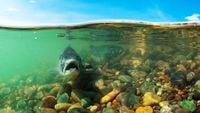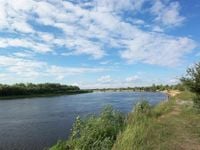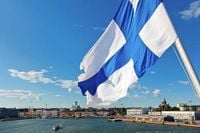Finland and Norway are intensifying their efforts to combat the invasive pink salmon that has been making its way into their rivers, posing a serious threat to local ecosystems. According to the Finnish publication Yle, the two countries are implementing joint measures aimed at preventing the mass reproduction of pink salmon and minimizing its negative impact on river biotopes.
The pink salmon, which was originally introduced into Russian waters in the 1950s, has been spreading through Scandinavian rivers over the past few decades, creating significant challenges for local fish species. Researchers emphasize that when pink salmon arrives at spawning grounds, it aggressively defends its territory, effectively displacing other fish species. Moreover, the fish's biennial spawning cycle leads to substantial ecological changes.
The Institute of Natural Resources of Finland (Luke) has pointed out that Norway plays a crucial role in managing the spread of pink salmon, as its rivers serve as the primary migration routes for the fish. Special focus is being placed on the Tanaelv River, known as Teno on the Finnish side, where a new dam has been constructed this year to completely block the river's width and prevent the fish's migration.
Finnish authorities are also taking proactive measures to stop the pink salmon from entering their waters. Previous attempts by Norway to limit the fish's access to the Teno River have proven insufficient, prompting both nations to develop new strategies for regulating the pink salmon population. In 2023, Norway set a record for the removal of pink salmon, with nearly 215,000 individuals caught.
This year, experts anticipate a peak migration in early July, and both countries are preparing for more active monitoring and control of the situation. One proposed method for managing the pink salmon is to increase commercial fishing efforts. Despite being recognized as an invasive species, pink salmon is considered a valuable food resource. According to Luke researcher Jaakko Erkinaro, pink salmon is known for its high taste quality and could attract interest from both local fishermen and tourists.
This is particularly significant given the ongoing ban on salmon fishing in the region, which has been in place for several years. Scientists warn that the spread of pink salmon is likely to continue, with its appearance in the Baltic Sea being only a matter of time. The fish has already been observed in the Danish straits and off the western coast of Sweden, raising concerns about potential ecological impacts.
Historically, pink salmon was artificially introduced into the rivers of the White Sea from the Far East of the USSR during the 1950s and 1960s, with the aim of boosting fish stocks. The so-called "odd line" of pink salmon, which spawns every two years, has established itself most successfully. However, the entire population dies after spawning, creating additional environmental risks.
Interestingly, amid rising prices for salmon species in Russia in 2024, pink salmon, despite its price increase being less than others, remained the least in demand among consumers, particularly in St. Petersburg. Meanwhile, in Norway, restrictions on wild salmon fishing were implemented in some regions in 2023 due to a sharp decline in the wild salmon population.
Additional pressure on the ecosystem is being exerted by salmon farms, which have nearly wiped out the vendace stocks in the Baltic Sea, as nearly all caught fish are used to feed farmed salmon. Both Finland and Norway continue their active fight against pink salmon, recognizing the risks this species poses to their aquatic resources.
New barriers and increased commercial fishing are expected to help regulate the pink salmon population, but achieving a definitive victory over this invasive species will require long-term strategies and international cooperation. The issue of pink salmon's spread in the Baltic Sea remains open, with ecologists continuing to monitor its movements closely.
Earlier reports indicated that Finland will not open its border with Russia until the end of 2025, adding another layer of complexity to the situation.



